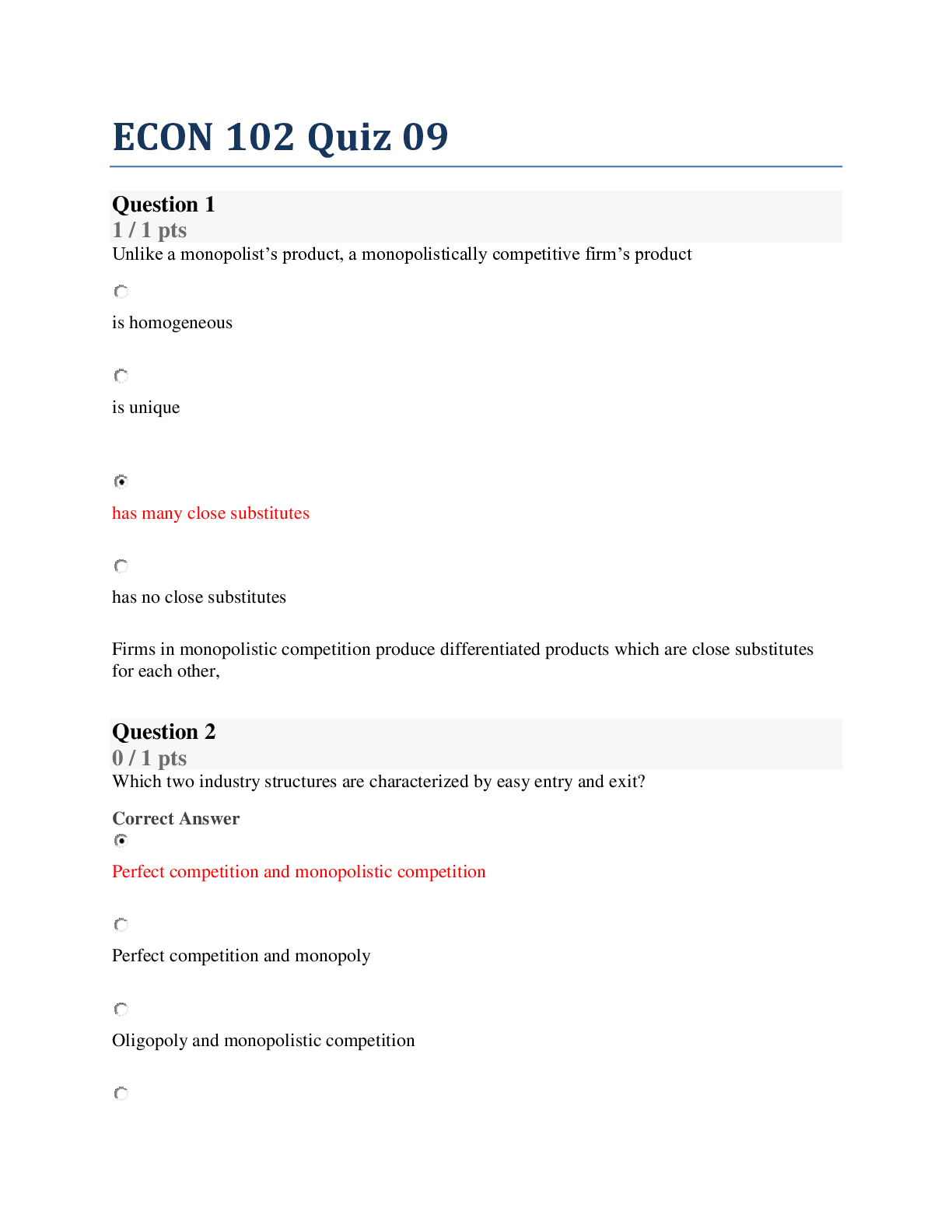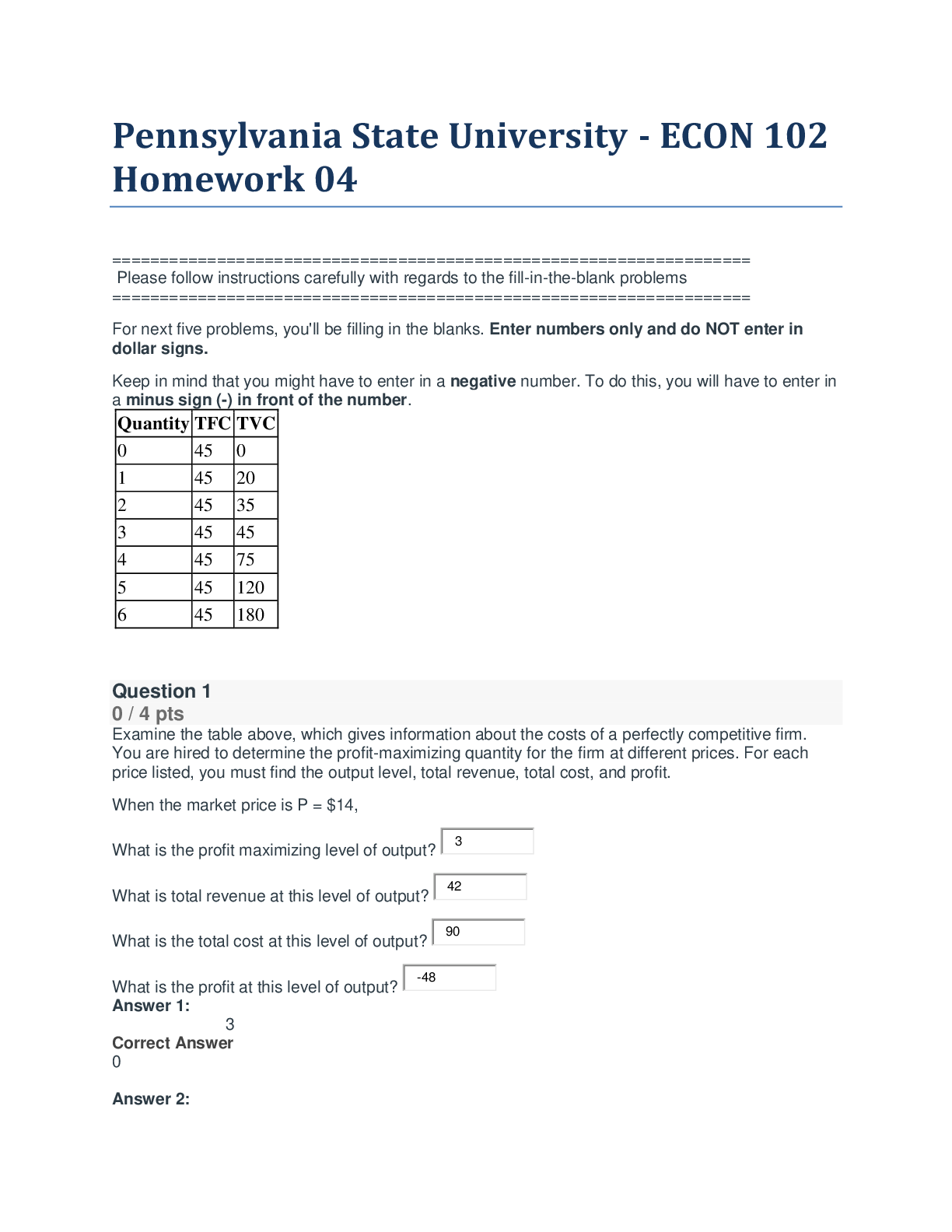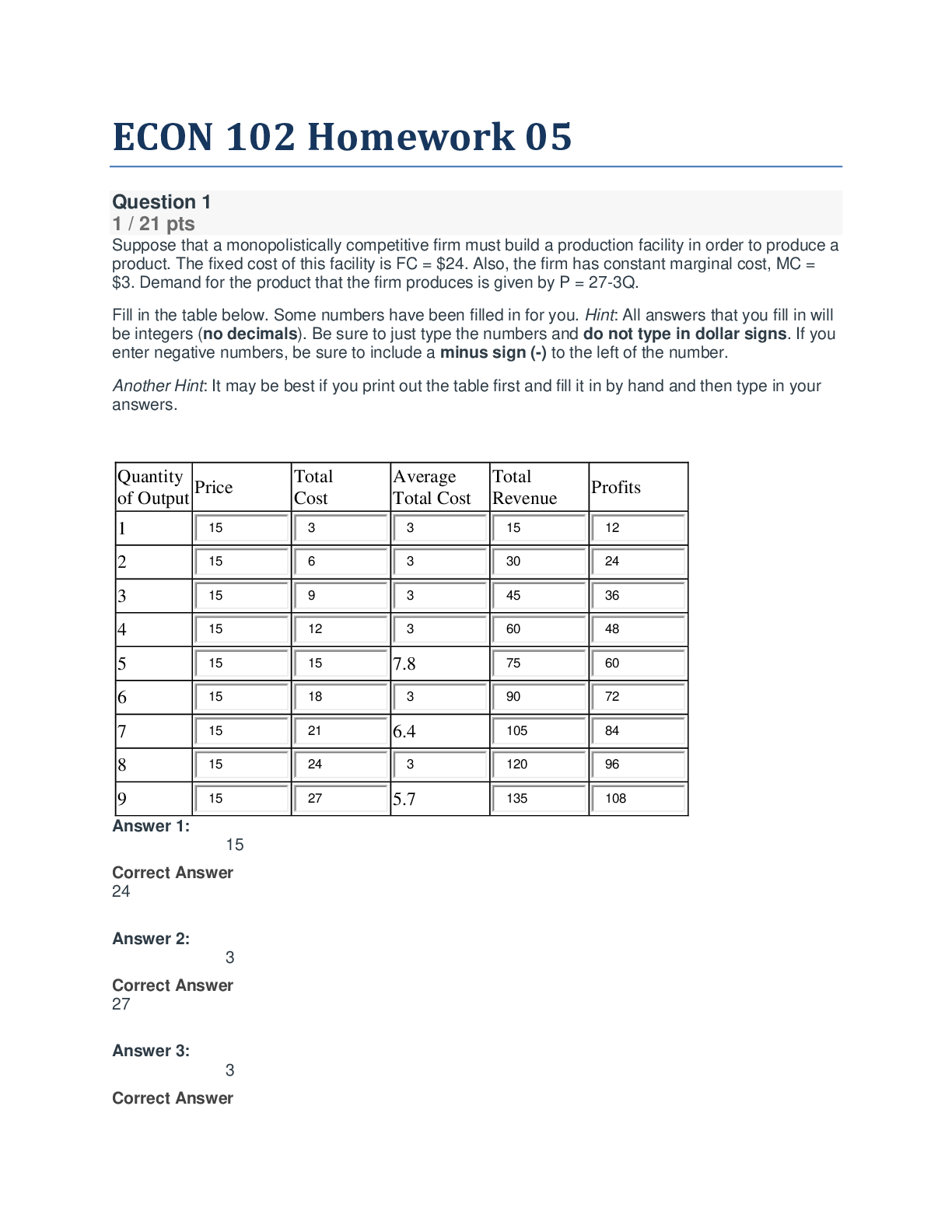Medicine > QUESTIONS & ANSWERS > AORN Review for Final Exam Latest 2022 Update;consists of the actual exam questions with all the cor (All)
AORN Review for Final Exam Latest 2022 Update;consists of the actual exam questions with all the correct answers
Document Content and Description Below
AORN Review for Final Exam Latest 2022 Update; consists of the actual exam questions with all the correct answers Which of the following statements are true about objective data? a. Data that cons... ists of the patient's own feelings and perceptions. b. Age, religion, or culture are examples of objective data. c. Data that is the information written in the patient's record and nursing notes. d. History, physical, and laboratory data are examples of objective data. -Answer- c. Data that is the information written in the patient's record and nursing notes. d. History, physical, and laboratory data are examples of objective data. Match the age groups with their ability for learning and understanding. 1. Birth to one month 2. 1-12 months 3. 1-3 years 4. 3-6 years a. The baby will smile, babble, and gurgle. b. The baby is able to understand and respond to simple commands. c. The child is able to literally interpret terms. d. The child is able to express only through crying. -Answer- 1. D 2. A 3. B 4. C Patients in which of the following age-groups have the greatest blood volume per unit of body weight. a. children b. elderly adults c. middle adults d. young adults -Answer- a. children During the preoperative interview, why should the perioperative nurse ask patients about their use of herbal preparations, alcohol, tobacco products, and recreational drugs? (select all that apply) a. herbal supplements may affect the metabolism of drugs administered b. patients who use alcohol heavily are unable to tolerate general anesthesia c. recreational drug use may affect the choice of preoperative sedation. d. smoking may affect circulatory and respiratory system assessment results. -Answer- a. herbal supplements may affect the metabolism of drugs administered c. recreational drug use may affect the choice of preoperative sedation d. smoking may affect circulatory and respiratory system assessment results. Which items below are included in a psychosocial assessment? (select all that apply) a. coping styles b. cultural beliefs and practices c. expectations of perioperative care d. sensory impairment e. spiritual or religious beliefs -Answer- a. coping styles b. cultural beliefs and practices c. expectations of perioperative care e. spiritual or religious beliefs Which of the following statements is true? a. blood pressure remains constant with age. b. body temperature increases with increasing age. c. heart rate increases with increasing age d. lung capacity decreases with increasing age -Answer- d. lung capacity decreases with increasing age Which of the following factors make geriatric patients more sensitive to injury and cold? a. decrease in subcutaneous fat b. lung capacity decreases with age c. bilirubin and hemoglobin shift d. rage of medication absorption is decreased -Answer- a. decrease in subcutaneous fat Why is it important to assess the use of herbal supplements or recreational drugs before surgery? a. herbal preparations can decrease the toxicity of other drugs administered during anesthesia. b. herbal preparations can affect bleeding times. c. herbal preparations can interfere with drug metabolism. d. recreational drug use can result in withdrawal symptoms. e. recreational drug users may require higher doses of anesthetic medications. -Answer- b. herbal preparations can affect bleeding times. c. herbal preparations can interfere with drug metabolism. d. recreational drug use can result in withdrawal symptoms. e. recreational drug users may require higher doses of anesthetic medications. What interventions can the perioperative nurse perform to protect elderly patients? a. employ deep vein thrombosis prophylactic devices. b. position the patient for effective air exchange. c. slide patient onto the OR bed without use of assistive device. d. use warming devices to maintain the normothermia. -Answer- a. employ deep vein thrombosis prophylactic devices. c. slide patient onto the OR bed without use of assistive device. d. use warming devices to maintain the normothermia. A child in which of the following age groups can be described as "likes to socialize and can interpret terms?" a. 1-12 months b. 1-3 years c. 3-6 years d. 6-12 years -Answer- c. 3-6 years After the preoperative assessment has been conducted on a patient, the perioperative nurse should document: a. cuts and abrasions b. preoperative hair removal, if ordered c. skin condition d. financial arrangements e. the patient's verbal consents for preoperative orders -Answer- a. cuts and abrasions b. preoperative hair removal, if ordered c. skin condition e. the patient's verbal consents for preoperative orders Based on the knowledge you have gained about preoperative orders, identify the preoperative orders that should be recorded. a. NPO orders b. skin preparation orders c. DNR orders d. patient's mental state of alertness e. medication orders -Answer- a. NPO orders b. skin preparation orders e. medication orders Based on the knowledge you have gained about preoperative orders, identify the preoperative orders that should be recorded. a. NPO orders b. skin preparation orders c. DNR orders d. patient's mental state of alertness e. medication orders -Answer- a. NPO orders b. skin preparation orders e. medication orders Which of the following statements are accurate regarding the documentation required for equipment used during operative procedures? 1. location of the dispersive electrode pad 2. the use of any warming/cooling blankets 3. the identification number on the laser 4. identification of the person that applied the tourniquet a. 2 & 4 b. 1, 3, & 4 c. 1, 2, & 4 d. 1, 2, 3,& 4 -Answer- d. 1, 2, 3, & 4 Based on the knowledge you have gained about documenting requirements, identify the true statements. a. You may be required to write out the physician's verbal orders for medications administered and have the physician sign the order. b. Hypersensitivity reactions should be documented. c. The manufacturer of implants should be documented. d. The manufacturer of the Foley catheter should be documented. e. Rationale for counts not performed should be documented. -Answer- a. You may be required to write out the physician's verbal orders for medications administered and have the physician sign the order. b. Hypersensitivity reactions should be documented. c. The manufacturer of implants should be documented. e. Rationale for counts not performed should be documented. A fluid imbalance may occur rapidly due to fluid loss as a result of: a. fluid restrictions b. accurate measurement of irrigation fluids c. wound drainage d. nasogastric tubes e. inadequate fluid replacement -Answer- a. fluid restrictions c. wound drainage d. nasogastric tubes e. inadequate fluid replacement Any tissue or fluid removed from the body is documented and identified. some of the items included in the documentation accompanying specimens are: a. site, location, type of dressing, loss of fluid b. type of specimen, date and time of collection, and hypersensitive reactions c. date and time of collection, site, surgeon's name and contact info -Answer- c. date and time of collection, site, surgeon's name and contact info When documenting a dressing, the name of the person applying the dressing should be noted. a. true b. false -Answer- b. false Based on the knowledge you have gained about using abbreviations, identify the true statements about abbreviations. a. Abbreviations are to be used by physicians only. b. Abbreviations can lead to medical errors. c. Abbreviations are difficult to read. d. Abbreviations might be wrongly interpreted. -Answer- b. Abbreviations can lead to medical errors. c. Abbreviations are difficult to read. d. Abbreviations might be wrongly interpreted. A successful lawsuit that an RN could be involved in: a. does not require patient injury b. only requires a nurse-patient relationship c. must show duty, breach, causation, and damages d. considers whether the patient has filed previous lawsuits -Answer- c. must show duty, breach, causation, and damages Based on the knowledge you have gained about legal aspects of documentation and nursing practice, which elements must be proved for a negligence claim to be successful? a. Damages: actual injury to the patient b. Breach of duty: care provided was not within the standard of care c. Reasonableness: a nurse in the same circumstance would have done the same thing d. Duty: a nurse-patient relationship exists e. Causation: what the nurse did or did not do resulted in patient injury -Answer- a. Damages: actual injury to the patient b. Breach of duty: care provided was not within the standard of care d. Duty: a nurse-patient relationship exists e. Causation: what the nurse did or did not do resulted in patient injury When documenting, always include your assessment of the situation, the actions you took, and the patient's response to them. a. True b. False -Answer- a. True Charting by exception is a time saver and ________. a. is easy even if you don't understand what is expected of a nurse b. does not require assessment skills c. is based on the premise that the patient manifests normal response to most interventions d. does not require documentation during the shift or notes on changes in the patient's progress -Answer- c. is based on the premise that the patient manifests normal response to most interventions Accurate preoperative documentation of the patient admission is an integral part of the nursing process. This includes: a. patient identification b. preoperative orders c. discharge referral d. patient assessment -Answer- a. patient identification b. preoperative orders d. patient assessment The primary purpose of documentation is to: a. be prepared in case a court case is filed b. make sure everything is written down c. record the chronological order of events during the nursing care of a patient d. relate any conversations and discussion with the patient or family in detail -Answer- c. record the chronological order of events during the nursing care of a patient When documenting the placement of a surgical drain, which of the following components should be included? a. date for expiration noted on the packaging b. manufacturer's name c. serial number d. where the drain was placed on the patient -Answer- d. where the drain was placed on the patient Which of the following is true about the use of abbreviations in perioperative documentation? a. there are only three possible words that could present problems in the clinical setting b. they are easy to interpret when writing orders c. they are not part of the Joint Commission and AORN safety goals d. they can put patients at risk for medication errors -Answer- d. they can put patients at risk for medication errors When documenting, the perioperative nurse should: a. document in a timely manner b. use medical diagnoses c. use nursing diagnoses based on sound judgement d. use patient statements to verify the nurse's findings e. document patient statements as facts -Answer- a. document in a timely manner c. use nursing diagnoses based on sound judgement d. use patient statements to verify the nurse's findings Which of the following statements are true about informed consent? a. Needs to state the indications for the proposed intervention b. Is a physician's duty, and the RNs are witnesses to the patient's signature c. Does not expose the nurse to liability if the nurse does not follow hospital policy d. Does not allow approved substitutes to give consent for patient e. Must contain the name of the health care facility. -Answer- a. Needs to state the indications for the proposed intervention b. Is a physician's duty, and the RNs are witnesses to the patient's signature e. Must contain the name of the health care facility. When documenting the use of a pneumatic tourniquet, which items should be included? a. cuff pressure b. location where the cuff was placed c. name of person who applied the tourniquet cuff d. name of person who inflated the tourniquet e. serial number of the unit -Answer- a. cuff pressure b. location where the cuff was placed c. name of person who applied the tourniquet cuff e. serial number of the unit The concept of a standard of care related to documentation: a. is not determined by hospital policy or AORN standards b. requires the nurse's care to be perfect c. requires the nurse to document and act as a reasonably qualified nurse would in a similar situation d. is set in law and never changes -Answer- c. requires the nurse to document and act as a reasonably qualified nurse would in a similar situation An individualized patient care plan that was initiated during the preoperative phase includes: a. cultural or religious preferences b. emotional considerations c. financial considerations d. psychosocial considerations -Answer- a. cultural or religious preferences b. emotional considerations d. psychosocial considerations The primary reason for documenting sharp, sponge, and instrument counts is: a. to prevent injury to the patient from a retained foreign object b. to maintain inventory for the sterile processing department c. to provide an accurate item charge for the patient d. to track instruments that might be needed for the next procedure -Answer- a. to prevent injury to the patient from a retained foreign object The use of powered air-purifying respirator (PAPR) is not recommended by the CDC because: a. the belt-mounted blower and tubing is designed to be worn on the inside of the gown. b. the device does not filter the wearer's exhaled air. c. the sterile field is protected by distance from the scrub team. d. none of the above. -Answer- b. the device does not filter the wearer's exhaled air. Identify which of the following statements are correct. (select all that apply) a. Perioperative personnel should wear a clean surgical mask that prevents venting of oropharyngeal and/or nasopharyngeal droplet dispersal. b. According to the CDC, PAPRs are suitable respiratory protection in the presence of a sterile field. c. Surgical gloves should be changed every 75-120 minutes. d. Gown sizes and critical zone configurations are specified by the manufacturer on the product label. -Answer- a. Perioperative personnel should wear a clean surgical mask that prevents venting of oropharyngeal and/or nasopharyngeal droplet dispersal. d. Gown sizes and critical zone configurations are specified by the manufacturer on the product label. [Show More]
Last updated: 2 years ago
Preview 1 out of 50 pages
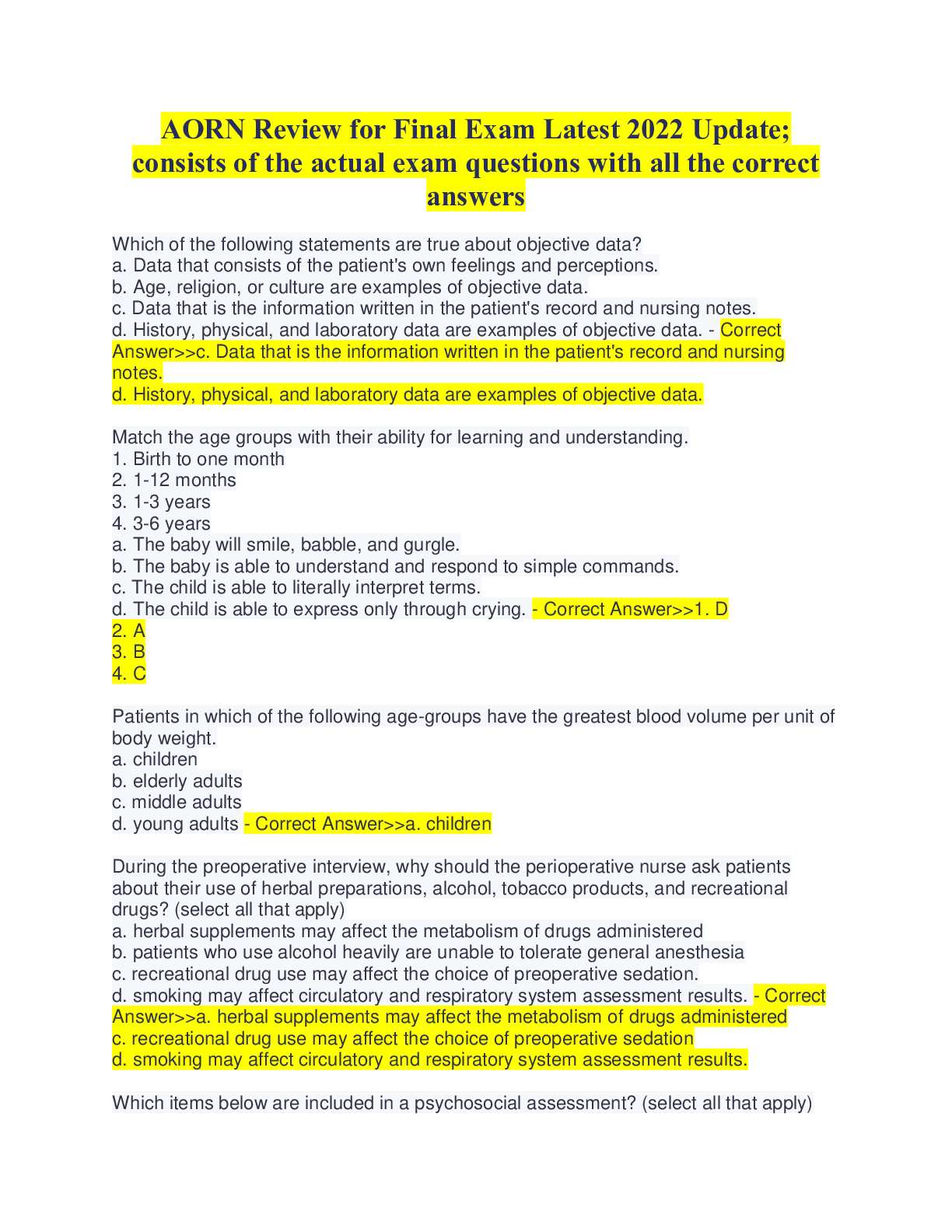
Buy this document to get the full access instantly
Instant Download Access after purchase
Buy NowInstant download
We Accept:

Reviews( 0 )
$7.00
Can't find what you want? Try our AI powered Search
Document information
Connected school, study & course
About the document
Uploaded On
Sep 22, 2022
Number of pages
50
Written in
Additional information
This document has been written for:
Uploaded
Sep 22, 2022
Downloads
0
Views
112

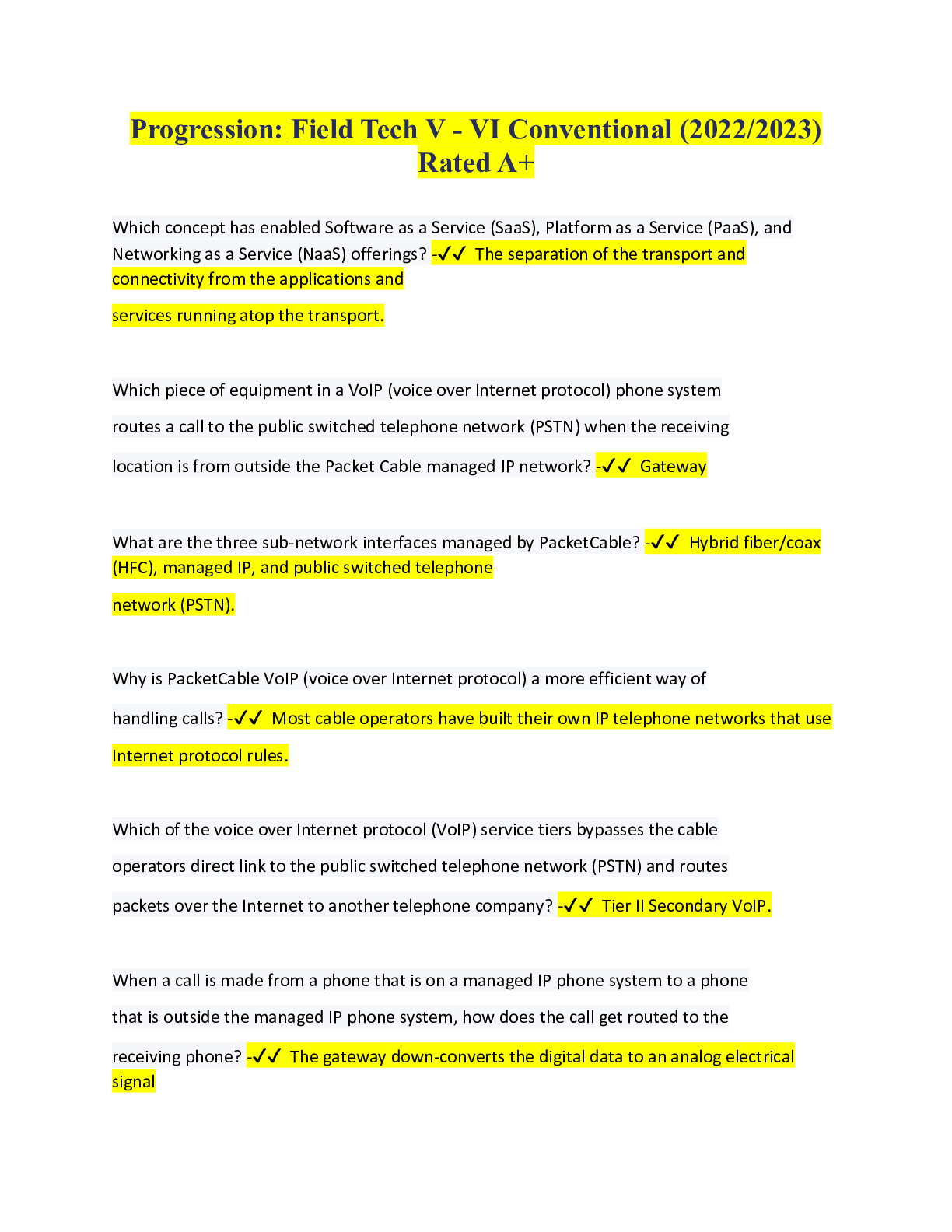
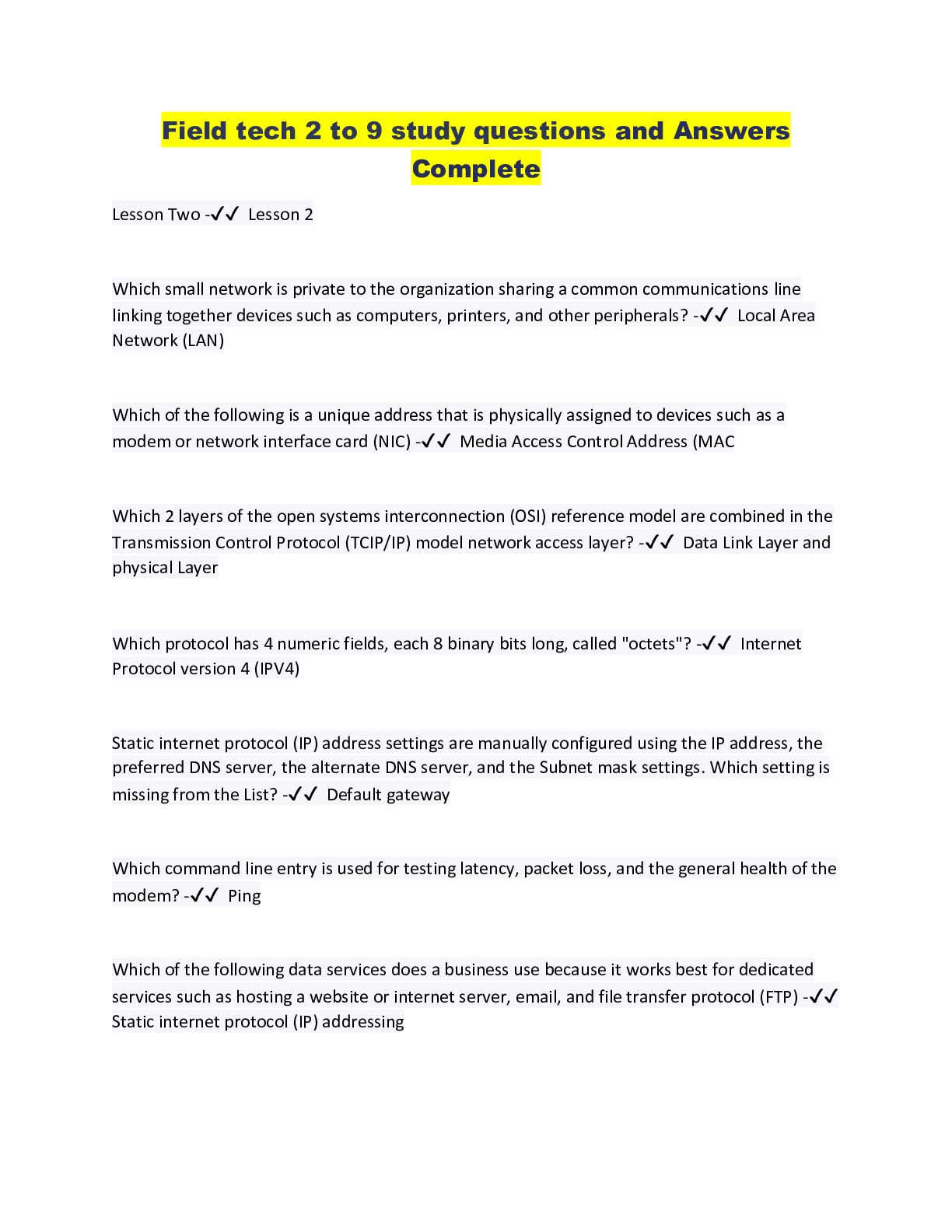
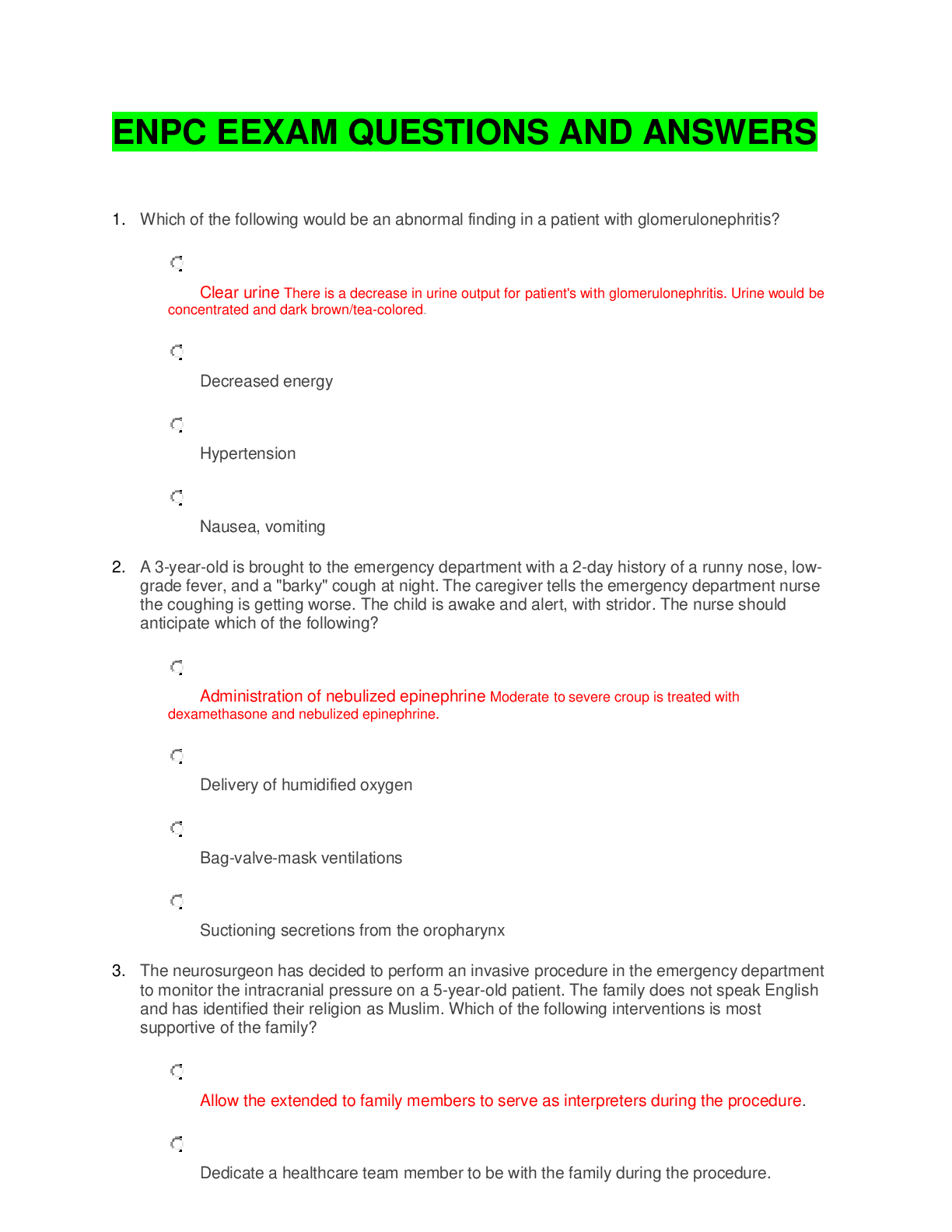
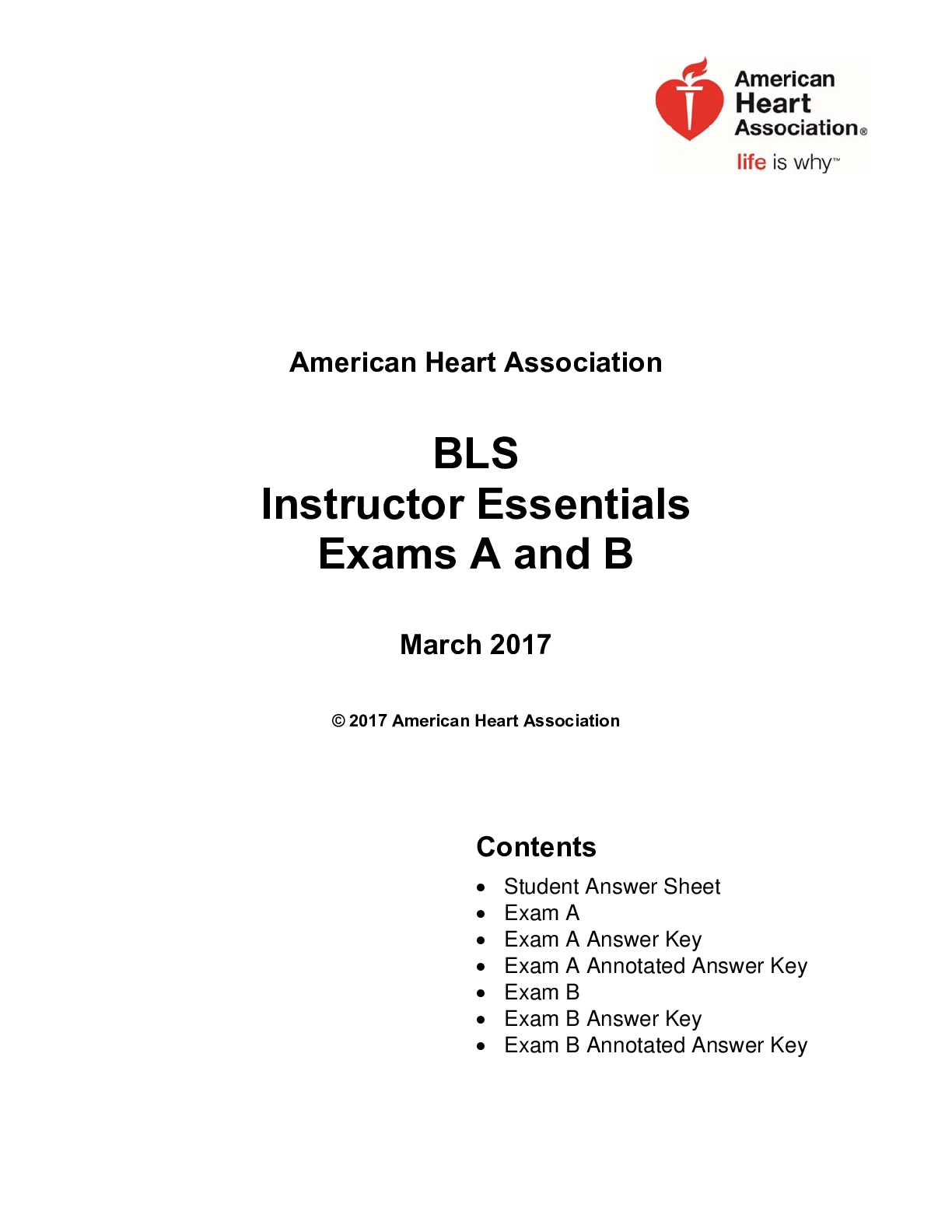

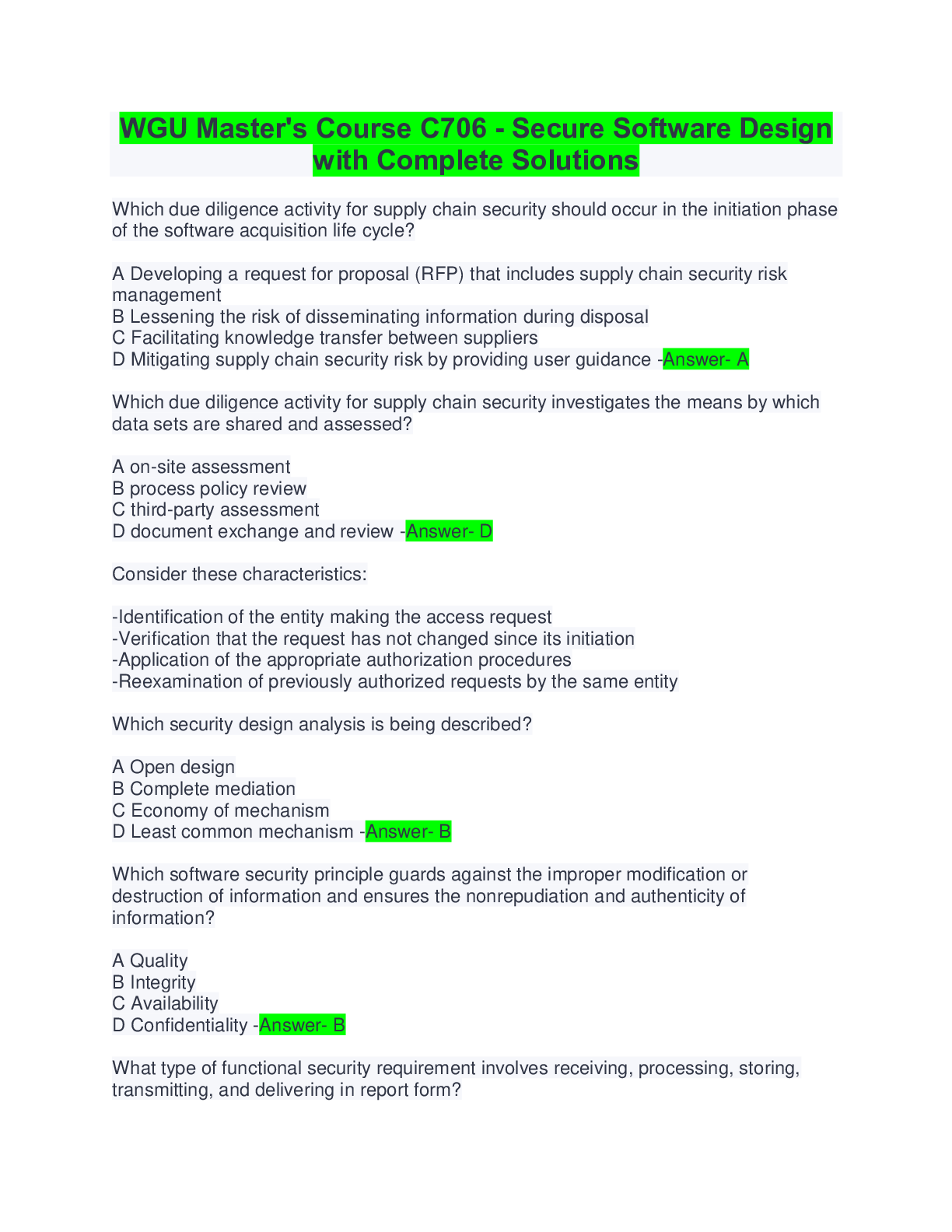

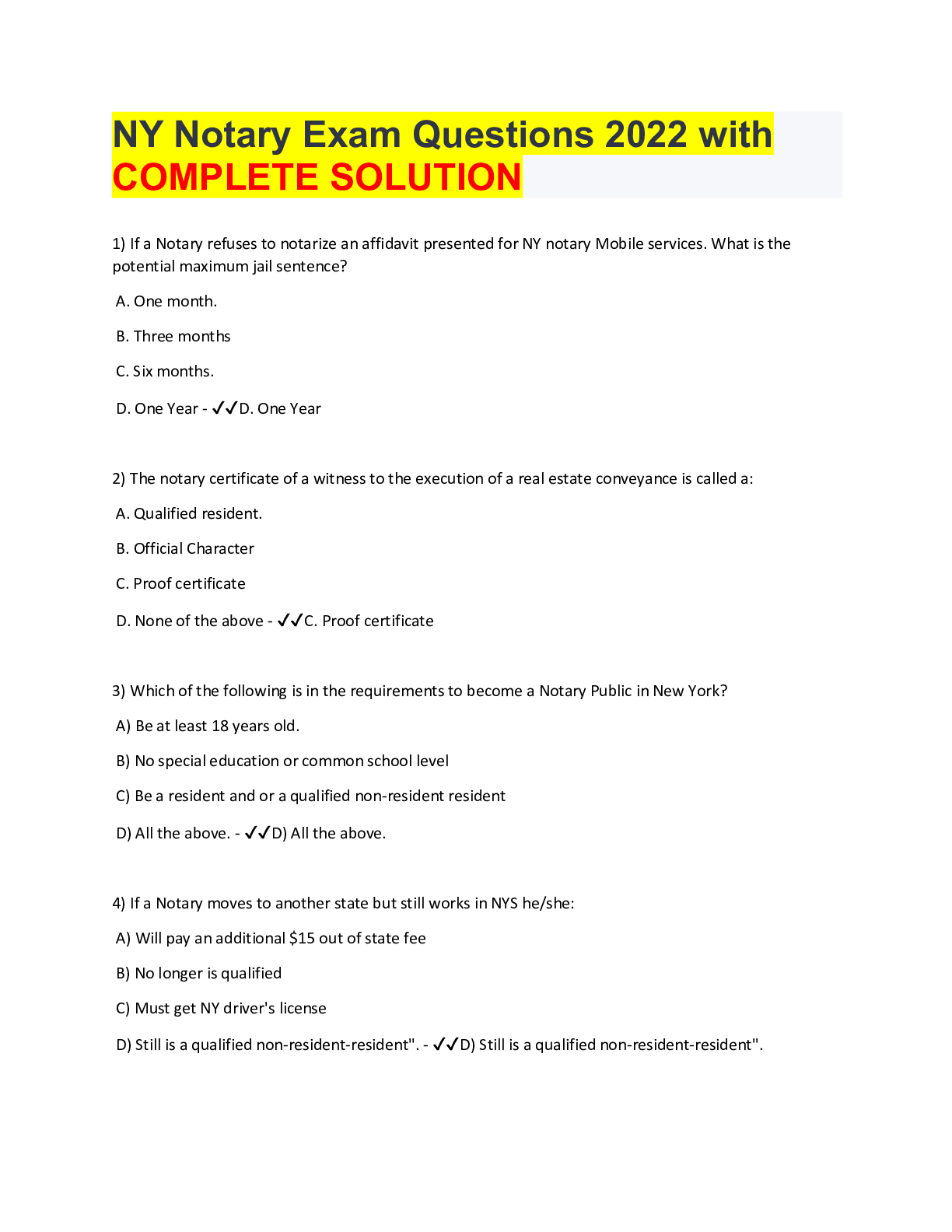
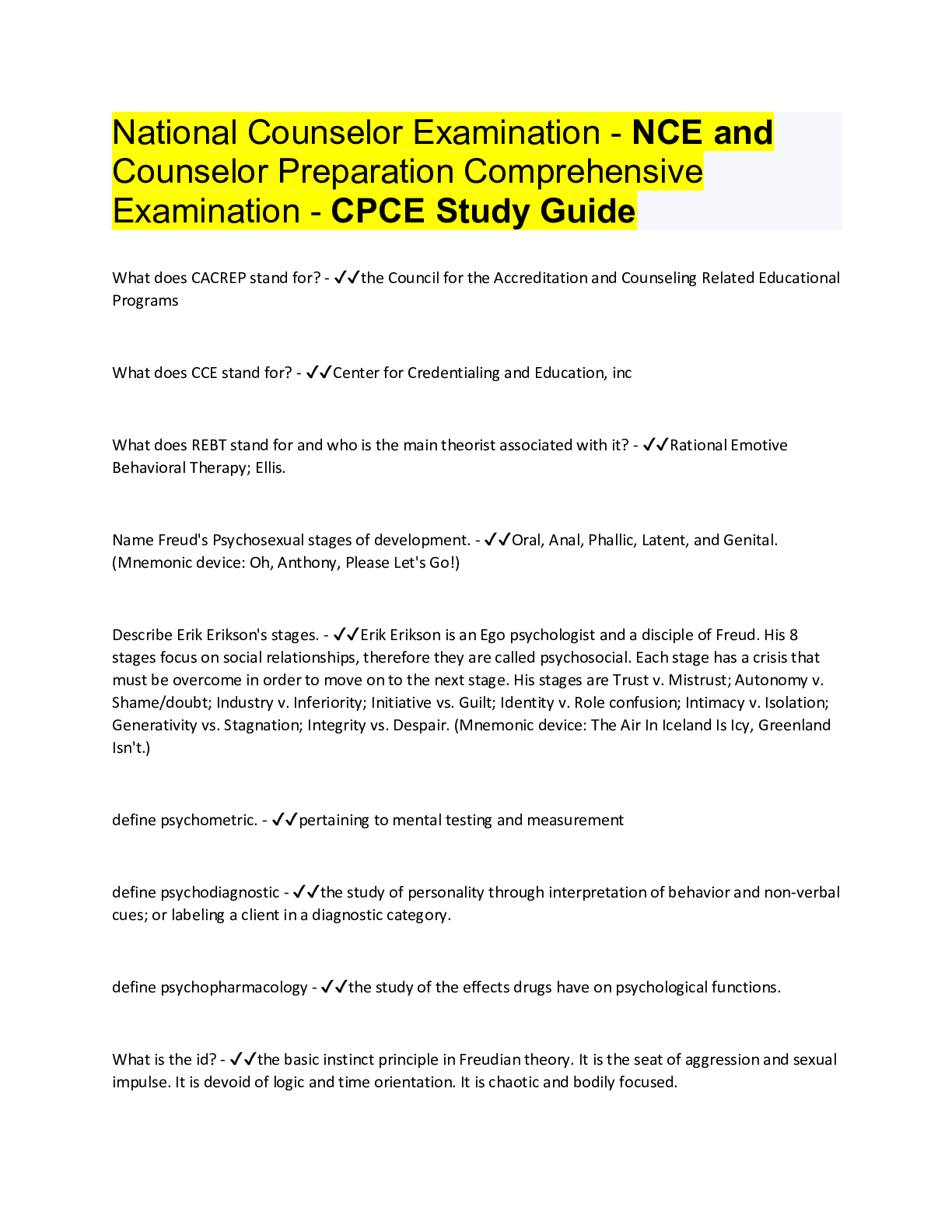
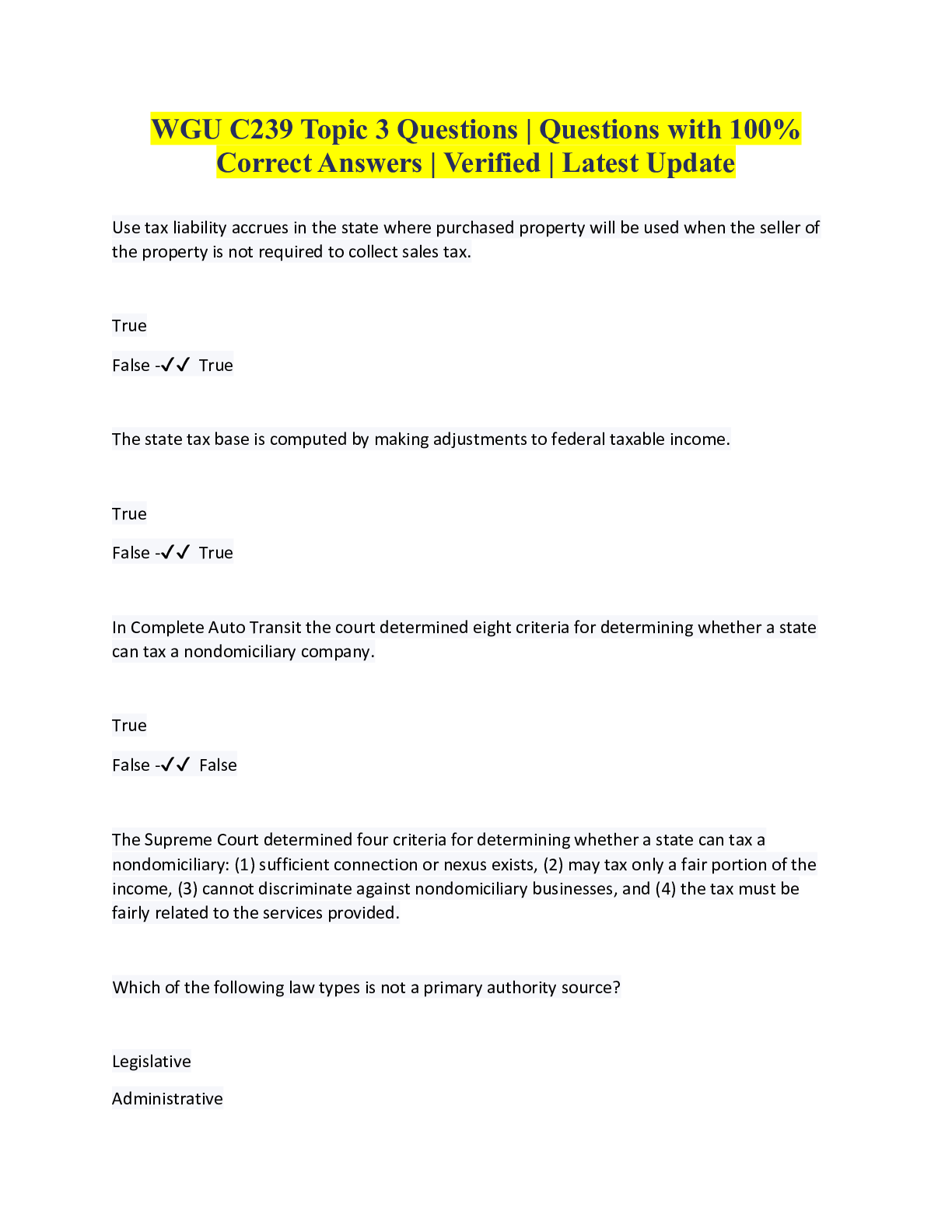
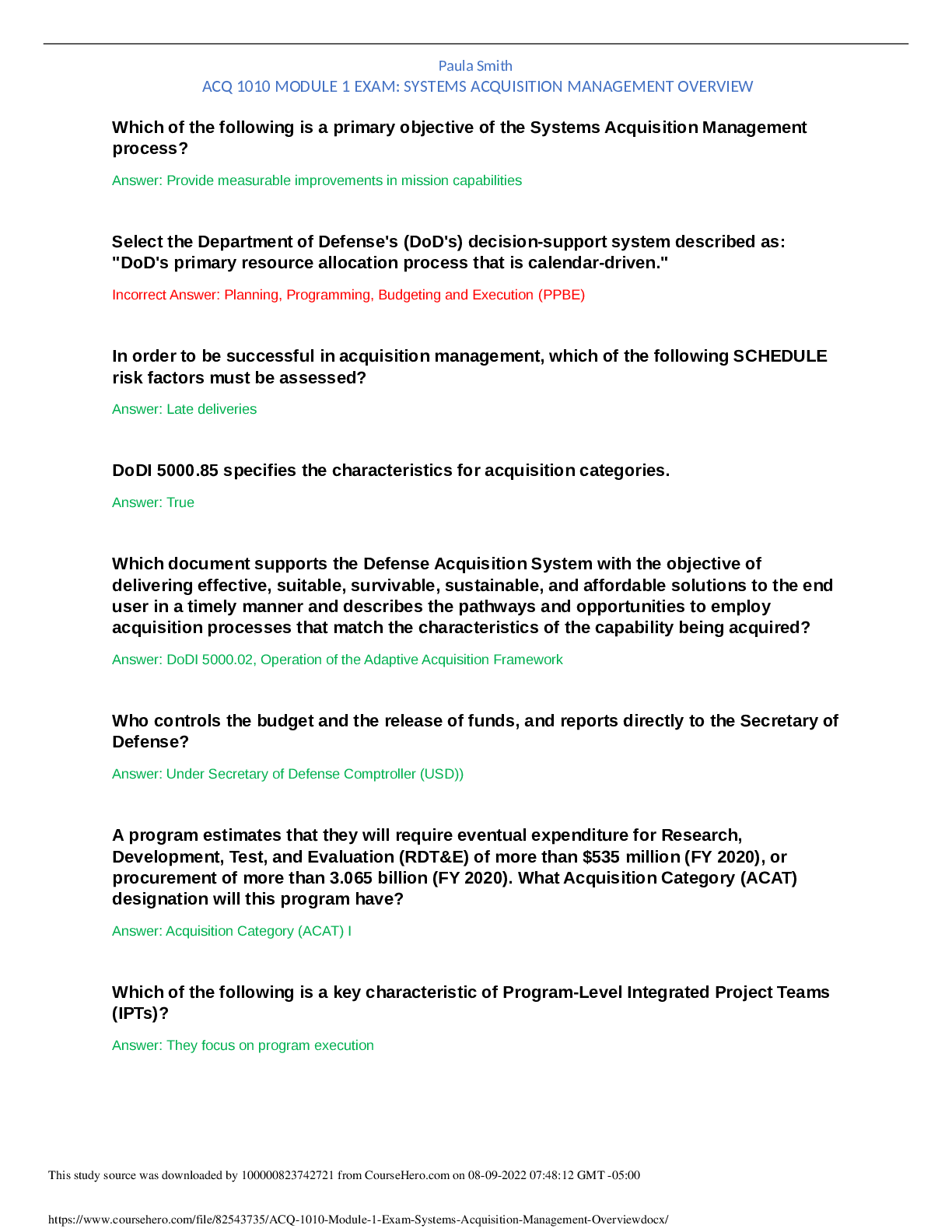
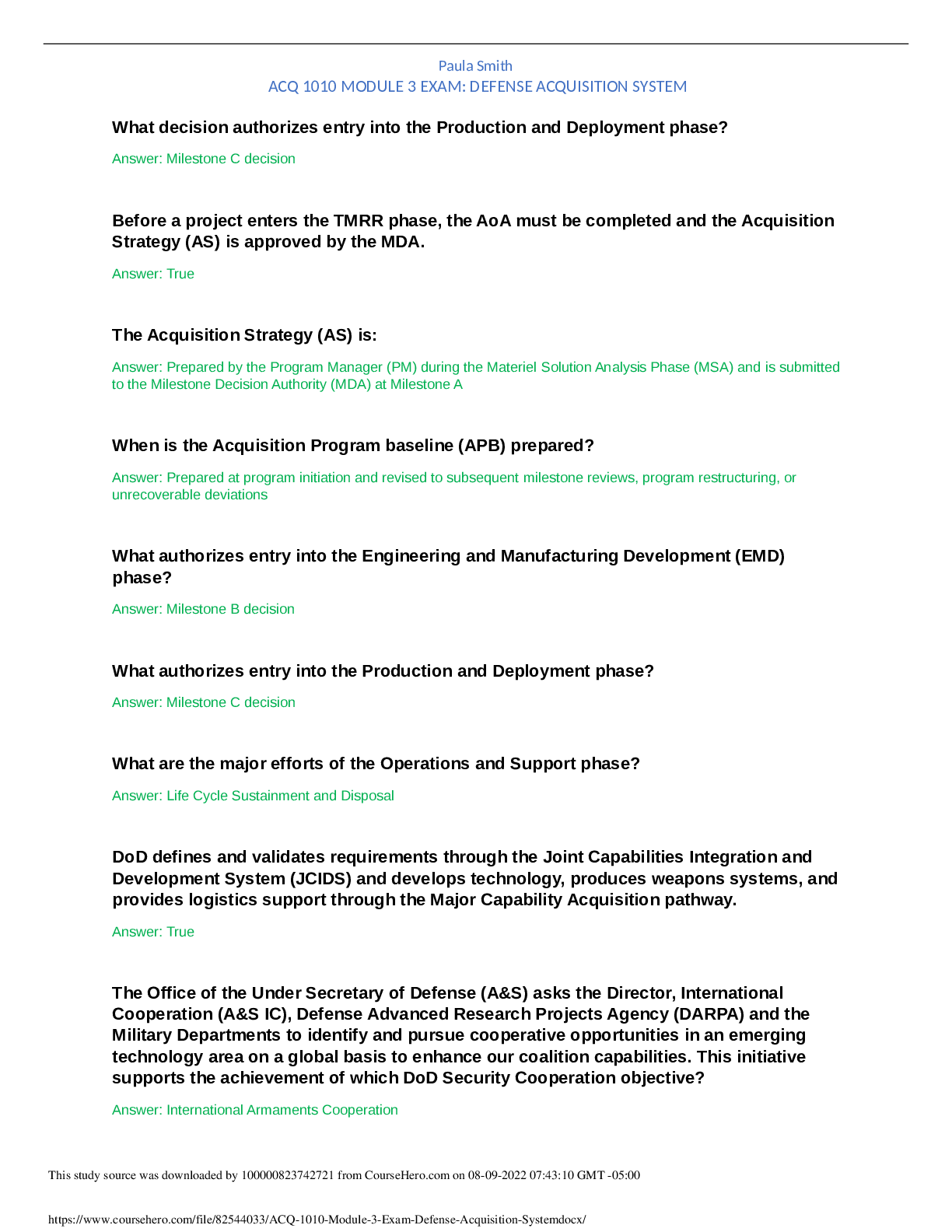





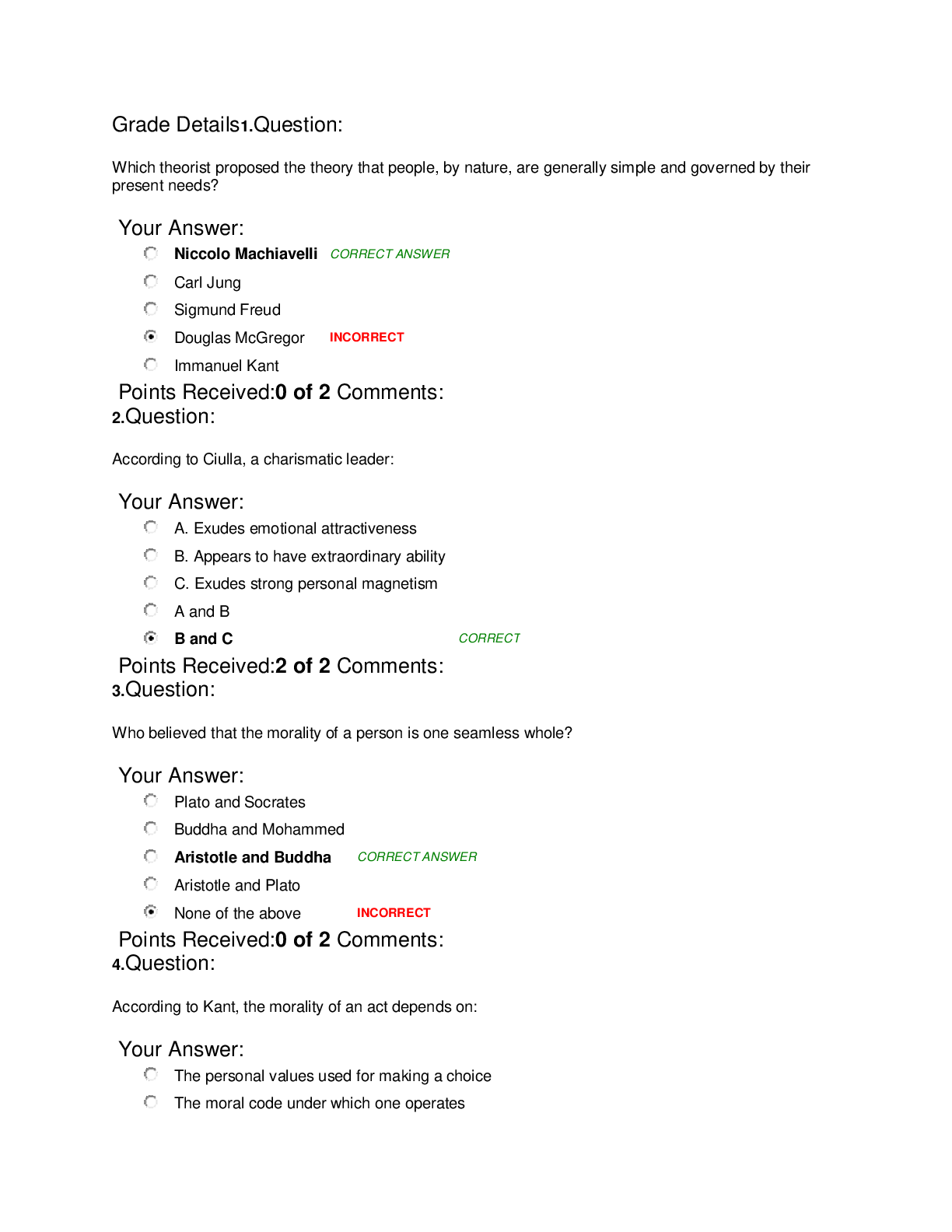

.png)
.png)
